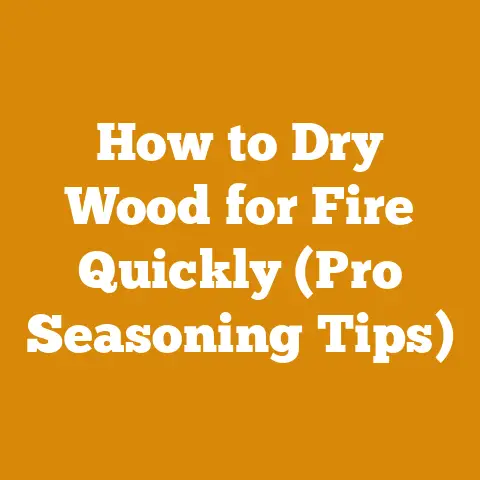Fire Bricks for Wood Stove (5 Expert Tips for Optimal Heat)
Let’s dive into the world of fire bricks and wood stoves. What makes a wood stove truly sing? It’s not just the wood, but also the often-overlooked fire bricks that line its interior. These unassuming blocks are the unsung heroes of efficient and safe wood burning. For years, I’ve been working with wood stoves, experimenting with different fire brick configurations, and learning firsthand what works and what doesn’t. I’m going to share my experiences and insights on how to optimize your wood stove’s heat output and longevity using the right fire brick techniques.
Fire Bricks for Wood Stove: 5 Expert Tips for Optimal Heat
Fire bricks aren’t just there to look pretty. They play a crucial role in how your wood stove performs. Think of them as the thermal heart of your stove, absorbing and radiating heat to maximize efficiency and protect the stove’s metal components. Over the years, I’ve discovered several key strategies for getting the most out of these workhorses. We’ll cover everything from selecting the right type of fire brick to proper installation and maintenance.
1. Understanding Fire Brick Types and Their Properties
Not all fire bricks are created equal. They come in different grades, each with varying heat resistance and thermal properties. Choosing the right type is the first step towards optimizing your wood stove’s performance.
Decoding Fire Brick Grades
Fire bricks are typically graded based on their alumina content, which directly affects their ability to withstand high temperatures.
- Low-Duty Fire Bricks: These bricks have a lower alumina content (around 25-30%) and are suitable for applications where temperatures don’t exceed 2,500°F (1,371°C). They’re often used in stoves with lower BTU outputs.
- Medium-Duty Fire Bricks: With an alumina content of 30-35%, these bricks can handle temperatures up to 2,700°F (1,482°C). They’re a good all-around choice for many wood stoves.
- High-Duty Fire Bricks: Boasting an alumina content of 35-40% or higher, these bricks can withstand temperatures exceeding 2,900°F (1,593°C). They’re ideal for stoves that are frequently used or operate at high temperatures.
My Experience: I once made the mistake of using low-duty fire bricks in a high-output stove. They cracked and crumbled within a single season. It was a costly lesson that taught me the importance of matching the brick grade to the stove’s requirements.
Key Properties to Consider
Besides the grade, consider these properties:
- Thermal Conductivity: This measures how well the brick conducts heat. Higher thermal conductivity means faster heat transfer.
- Thermal Mass: This refers to the brick’s ability to store heat. Higher thermal mass means the brick will retain heat for longer periods.
- Spalling Resistance: This is the brick’s ability to withstand rapid temperature changes without cracking or breaking.
Pro Tip: Look for fire bricks that are specifically designed for wood stoves. These bricks are typically denser and have better spalling resistance than generic fire bricks.
Choosing the Right Brick for Your Stove
To determine the right type of fire brick for your wood stove, consult your stove’s manual. The manufacturer will usually specify the recommended grade and dimensions. If the manual is unavailable, consider the stove’s BTU output and usage frequency. For high-output stoves used regularly, opt for high-duty fire bricks. For smaller stoves used occasionally, medium-duty bricks may suffice.
Actionable Metric: Track the number of hours you use your wood stove each season. If you consistently burn for more than 5 hours per day, consider upgrading to high-duty fire bricks.
Takeaway: Selecting the right type of fire brick is crucial for maximizing your wood stove’s efficiency and longevity. Consider the grade, thermal properties, and your stove’s specific requirements.
2. Proper Installation Techniques for Maximum Efficiency
Even the best fire bricks won’t perform well if they’re not installed correctly. Proper installation ensures optimal heat transfer, protects the stove’s metal components, and prevents premature brick failure.
Preparing the Stove
Before installing new fire bricks, thoroughly clean the stove’s interior. Remove any ash, debris, or loose mortar. Inspect the stove’s walls for cracks or damage. Repair any issues before proceeding.
My Experience: I once installed fire bricks in a stove without properly cleaning it. The residual ash created an uneven surface, which led to poor heat transfer and premature brick cracking.
Mortar Selection and Application
Use a high-temperature refractory mortar specifically designed for fire bricks. Avoid using regular mortar, as it will not withstand the high temperatures inside a wood stove.
- Mixing the Mortar: Follow the manufacturer’s instructions for mixing the mortar. The consistency should be similar to that of peanut butter.
- Applying the Mortar: Apply a thin, even layer of mortar to the back and sides of each fire brick. Use a trowel to ensure proper coverage.
Pro Tip: Soak the fire bricks in water for a few minutes before applying the mortar. This will prevent the bricks from absorbing moisture from the mortar, ensuring a stronger bond.
Brick Placement and Alignment
Carefully place each fire brick in its designated position. Ensure that the bricks are flush with each other and with the stove’s walls. Use a rubber mallet to gently tap the bricks into place.
- Staggering the Joints: Stagger the joints between the fire bricks to improve structural integrity. This is similar to how bricks are laid in a wall.
- Maintaining Proper Spacing: Leave a small gap (about 1/8 inch) between the fire bricks to allow for expansion and contraction.
Actionable Metric: Measure the gaps between the fire bricks using a feeler gauge. Ensure that the gaps are consistent and within the recommended range.
Curing the Mortar
After installing the fire bricks, allow the mortar to cure for at least 24 hours before using the stove. This will allow the mortar to harden and bond properly with the bricks.
My Experience: I once rushed the curing process and fired up the stove too soon. The mortar cracked and crumbled, requiring me to redo the entire installation.
Takeaway: Proper installation is essential for maximizing the performance and longevity of your fire bricks. Clean the stove thoroughly, use high-temperature mortar, and ensure proper brick placement and alignment.
3. Optimizing Fire Brick Configuration for Heat Distribution
The arrangement of fire bricks within your wood stove can significantly impact heat distribution and overall efficiency. Experimenting with different configurations can help you find the optimal setup for your specific stove and heating needs.
Understanding Heat Flow
Heat naturally rises. Therefore, the placement of fire bricks can either enhance or hinder this natural flow. Strategic placement can help direct heat towards specific areas of the stove, maximizing its effectiveness.
Pro Tip: Consider the design of your wood stove. Some stoves have built-in baffles or air channels that are designed to work in conjunction with the fire bricks. Follow the manufacturer’s recommendations for brick placement in these cases.
Common Fire Brick Configurations
Here are a few common fire brick configurations and their benefits:
- Standard Configuration: This involves lining the entire firebox with fire bricks. This provides maximum protection for the stove’s metal components and helps to distribute heat evenly.
- Baffle Configuration: This involves placing fire bricks in a baffle pattern, creating a barrier that forces hot gases to circulate longer within the stove. This increases heat extraction and reduces emissions.
- Raised Hearth Configuration: This involves raising the hearth (the bottom of the firebox) with fire bricks. This can improve combustion efficiency by providing better airflow to the fire.
My Experiment: I once experimented with a raised hearth configuration in a small wood stove. It significantly improved the stove’s draft and reduced the amount of smoke produced.
Customizing Your Configuration
Don’t be afraid to experiment with different fire brick configurations to find what works best for your stove. Consider the following factors:
- Stove Size: Larger stoves may benefit from more complex configurations, while smaller stoves may only require a standard configuration.
- Heating Needs: If you need to heat a specific area of your home, consider placing fire bricks in a way that directs heat towards that area.
- Wood Type: Different wood types burn at different temperatures. Adjust the fire brick configuration to optimize heat extraction for the type of wood you typically use.
Actionable Metric: Measure the temperature of different areas of your stove using an infrared thermometer. Use this data to fine-tune your fire brick configuration for optimal heat distribution.
Takeaway: Optimizing your fire brick configuration can significantly improve your wood stove’s efficiency and heat distribution. Experiment with different configurations to find what works best for your stove and heating needs.
4. Maintaining Fire Bricks for Longevity
Fire bricks, like any other component of your wood stove, require regular maintenance to ensure their longevity and performance. Proper maintenance can prevent premature failure and extend the lifespan of your fire bricks by several years.
Regular Inspections
Inspect your fire bricks regularly for signs of damage, such as cracks, chips, or crumbling. Pay close attention to areas that are exposed to high temperatures or direct flame.
My Experience: I once neglected to inspect my fire bricks for an entire season. By the time I finally checked them, several bricks were severely damaged and needed to be replaced.
Cleaning and Ash Removal
Remove ash and debris from the fire bricks regularly. Ash can accumulate and insulate the bricks, reducing their ability to absorb and radiate heat. Use a brush or vacuum to remove loose ash.
Pro Tip: Avoid using harsh chemicals or abrasive cleaners on your fire bricks. These can damage the bricks and reduce their lifespan.
Repairing Minor Damage
Small cracks or chips in fire bricks can often be repaired using refractory mortar. Clean the damaged area thoroughly and apply a thin layer of mortar. Allow the mortar to cure completely before using the stove.
Caution: If the damage is severe or if the cracks are large, it’s best to replace the fire brick entirely. Attempting to repair severely damaged bricks can be dangerous.
Replacing Damaged Bricks
When replacing fire bricks, use the same type and grade of brick as the original. Follow the installation techniques outlined in section 2.
Actionable Metric: Keep a log of when you inspect and maintain your fire bricks. This will help you track their condition and identify potential problems early on.
Takeaway: Regular maintenance is crucial for extending the lifespan of your fire bricks. Inspect them regularly, remove ash and debris, and repair minor damage promptly.
5. Troubleshooting Common Fire Brick Problems
Even with proper installation and maintenance, fire bricks can sometimes experience problems. Knowing how to troubleshoot these issues can save you time and money.
Cracking
Cracking is a common problem with fire bricks, especially in stoves that are used frequently or operate at high temperatures.
- Causes: Cracking can be caused by rapid temperature changes, excessive heat, or improper installation.
- Solutions: If the cracks are small, they can often be repaired with refractory mortar. If the cracks are large or if the brick is severely damaged, it should be replaced.
My Experience: I once had a fire brick crack in a stove that I was using to burn green wood. The high moisture content of the wood caused rapid temperature changes, which led to the cracking.
Crumbling
Crumbling is another common problem with fire bricks, especially in stoves that are exposed to moisture or corrosive substances.
- Causes: Crumbling can be caused by moisture, corrosive substances, or the use of low-quality fire bricks.
- Solutions: Replace the crumbling fire bricks with high-quality bricks that are designed for wood stoves. Ensure that the stove is properly ventilated to prevent moisture buildup.
Spalling
Spalling is a condition in which the surface of the fire brick flakes or peels off.
- Causes: Spalling is typically caused by rapid temperature changes or the use of fire bricks that are not designed for wood stoves.
- Solutions: Replace the spalling fire bricks with high-quality bricks that are designed for wood stoves. Avoid rapid temperature changes by gradually increasing the fire’s intensity.
Mortar Failure
The mortar that holds the fire bricks in place can also fail over time.
- Causes: Mortar failure can be caused by excessive heat, moisture, or the use of low-quality mortar.
- Solutions: Remove the old mortar and replace it with high-temperature refractory mortar. Ensure that the mortar is properly mixed and applied.
Actionable Metric: Track the frequency and severity of fire brick problems. This will help you identify potential causes and implement preventative measures.
Takeaway: Troubleshooting common fire brick problems can save you time and money. Identify the cause of the problem and implement the appropriate solution.
By following these five expert tips, you can optimize your wood stove’s heat output, extend the lifespan of your fire bricks, and enjoy a more efficient and safer wood-burning experience. Remember, proper fire brick selection, installation, maintenance, and troubleshooting are key to maximizing the performance of your wood stove.






